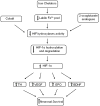Hypoxia inducible factor-1 as a target for neurodegenerative diseases
- PMID: 21861815
- PMCID: PMC3213300
- DOI: 10.2174/092986711797200426
Hypoxia inducible factor-1 as a target for neurodegenerative diseases
Abstract
Hypoxia inducible factor-1 (HIF-1) is a transcriptional factor responsible for cellular and tissue adaption to low oxygen tension. HIF-1, a heterodimer consisting of a constitutively expressed β subunit and an oxygen-regulated α subunit, regulates a series of genes that participate in angiogenesis, iron metabolism, glucose metabolism, and cell proliferation/survival. The activity of HIF-1 is controlled by post-translational modifications on different amino acid residues of its subunits, mainly the alpha subunit. Besides in ischemic stroke (see review [1]), emerging evidence has revealed that HIF-1 activity and expression of its down-stream genes, such as vascular endothelial growth factor and erythropoietin, are altered in a range of neurodegenerative diseases. At the same time, experimental and clinical evidence has demonstrated that regulating HIF-1 might ameliorate the cellular and tissue damage in the neurodegenerative diseases. These new findings suggest HIF-1 as a potential medicinal target for the neurodegenerative diseases. This review focuses on HIF-1α protein modifications and HIF-1's potential neuroprotective roles in Alzheimer's (AD), Parkinson's (PD), Huntington's diseases (HD), and amyotrophic lateral sclerosis (ALS).
Figures
Similar articles
-
Novel therapeutic approach for neurodegenerative pathologies: multitarget iron-chelating drugs regulating hypoxia-inducible factor 1 signal transduction pathway.Neurodegener Dis. 2012;10(1-4):112-5. doi: 10.1159/000332597. Epub 2011 Dec 9. Neurodegener Dis. 2012. PMID: 22156453 Review.
-
Hypoxia-inducible factor-1 (HIF-1).Mol Pharmacol. 2006 Nov;70(5):1469-80. doi: 10.1124/mol.106.027029. Epub 2006 Aug 3. Mol Pharmacol. 2006. PMID: 16887934 Review.
-
Neuroprotective multifunctional iron chelators: from redox-sensitive process to novel therapeutic opportunities.Antioxid Redox Signal. 2010 Sep 15;13(6):919-49. doi: 10.1089/ars.2009.2929. Antioxid Redox Signal. 2010. PMID: 20095867 Review.
-
The Role of Oxygen Homeostasis and the HIF-1 Factor in the Development of Neurodegeneration.Int J Mol Sci. 2024 Apr 23;25(9):4581. doi: 10.3390/ijms25094581. Int J Mol Sci. 2024. PMID: 38731800 Free PMC article. Review.
-
Understanding the Role of Hypoxia Inducible Factor During Neurodegeneration for New Therapeutics Opportunities.Curr Neuropharmacol. 2018;16(10):1484-1498. doi: 10.2174/1570159X16666180110130253. Curr Neuropharmacol. 2018. PMID: 29318974 Free PMC article. Review.
Cited by
-
Exploration on the Mechanism of Ubiquitin Proteasome System in Cerebral Stroke.Front Aging Neurosci. 2022 Apr 7;14:814463. doi: 10.3389/fnagi.2022.814463. eCollection 2022. Front Aging Neurosci. 2022. PMID: 35462700 Free PMC article. Review.
-
Single injection of sustained-release prostacyclin analog ONO-1301-MS ameliorates hypoxic toxicity in the murine model of amyotrophic lateral sclerosis.Sci Rep. 2019 Mar 27;9(1):5252. doi: 10.1038/s41598-019-41771-4. Sci Rep. 2019. PMID: 30918303 Free PMC article.
-
Anticancer potential of emodin.Biomedicine (Taipei). 2012 Sep;2(3):108-116. doi: 10.1016/j.biomed.2012.03.003. Epub 2012 May 11. Biomedicine (Taipei). 2012. PMID: 32289000 Free PMC article. Review.
-
A Rationale for Hypoxic and Chemical Conditioning in Huntington's Disease.Int J Mol Sci. 2021 Jan 8;22(2):582. doi: 10.3390/ijms22020582. Int J Mol Sci. 2021. PMID: 33430140 Free PMC article. Review.
-
Implications for soluble iron accumulation, oxidative stress, and glial glutamate release in motor neuron death associated with sporadic amyotrophic lateral sclerosis.Neuropathology. 2025 Jun;45(3):177-201. doi: 10.1111/neup.13033. Epub 2025 Mar 10. Neuropathology. 2025. PMID: 40065552 Free PMC article. Review.
References
-
- Ke Q, Costa M. Hypoxia-inducible factor-1 (HIF-1) Mol Pharmacol. 2006;70(5):1469–1480. - PubMed
Publication types
MeSH terms
Substances
Grants and funding
LinkOut - more resources
Full Text Sources
Other Literature Sources
Medical
Miscellaneous




